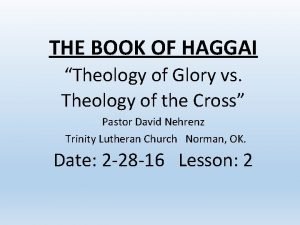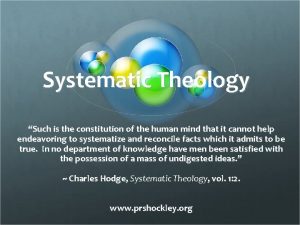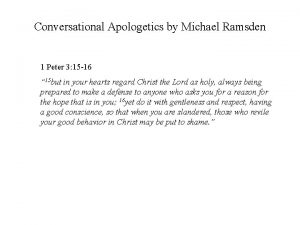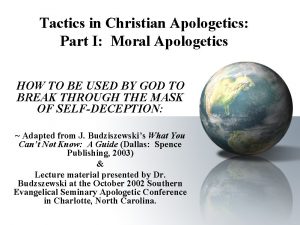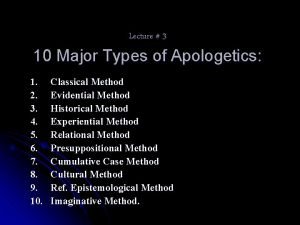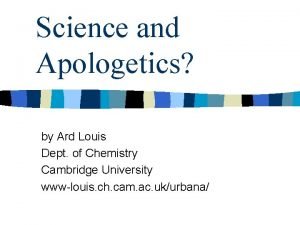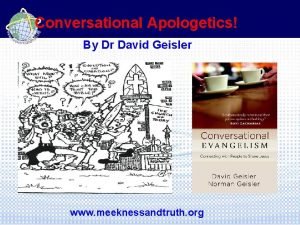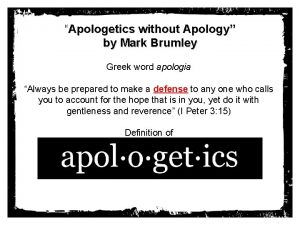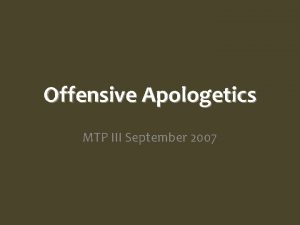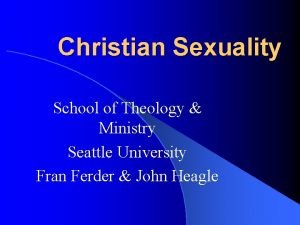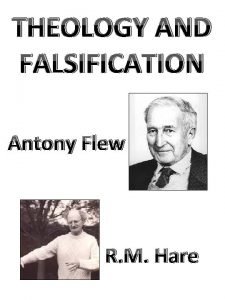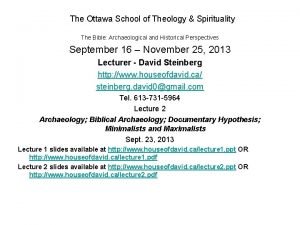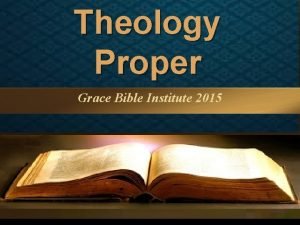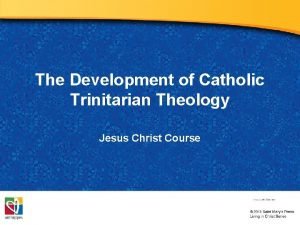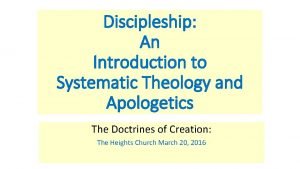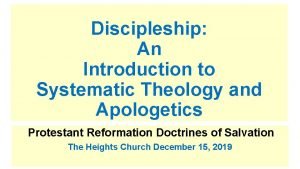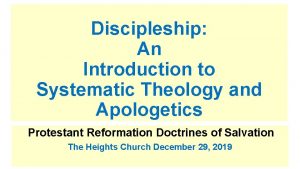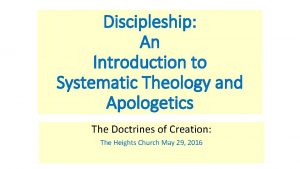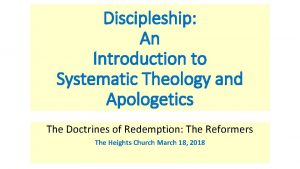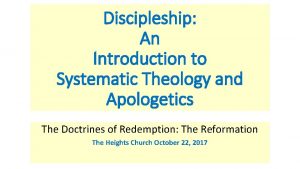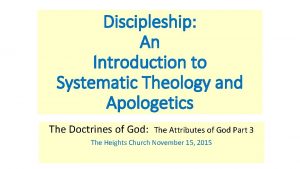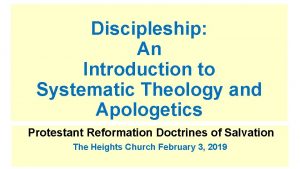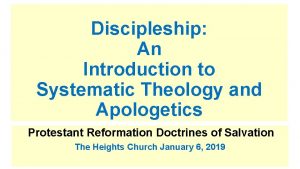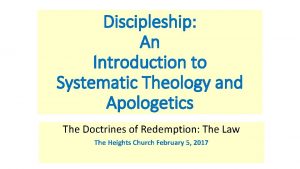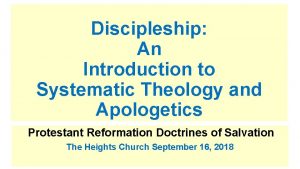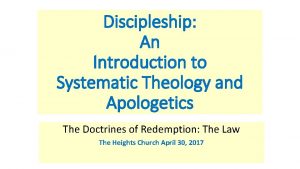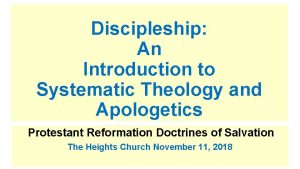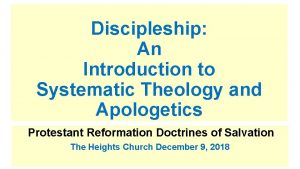Discipleship An Introduction to Systematic Theology and Apologetics
















- Slides: 16

Discipleship: An Introduction to Systematic Theology and Apologetics The Doctrines of Redemption: The Reformation The Heights Church November 12, 2017

The Reformation – Setting the Table for October 31, 1517 • Pre-Reformation Roman Catholicism • “Church Fathers” preserve Christianity • Constantine to Charlemagne (306 – 800) • 11 th and 12 th Century theologians • 13 th Century (The Wondrous Century) • 14 th and 15 th Century • 16 th century through the Council of Trent

The Reformation (13 th century) – Romanesque Cathedral

The Reformation (13 th century) – Gothic Cathedral Flying Buttress

The Reformation (13 th century) – Gothic Cathedral

The Reformation (13 th century) – Monks and Friars • • The 13 th century began a shift in population from rural to city life. By the 13 th century monks were giving way to friars. Friars are different from monks in that they are called to live the evangelical counsels (vows of poverty, chastity and obedience) in service to society, rather than through cloistered asceticism and devotion. In the 13 th century three mendicant (beggars) orders arose. The two dominate orders were the Franciscans and Dominicans. The Augustinian Hermits were third order approved by pope Innocent IV December 16, 1243 and followed the “rule of St Augustine”. From the perspective of the reformation the most important friar of all time was Frater Martinus Lutherus. The Jesuit order played an important role in the Counter-Reformation and eventually succeeded in converting millions around the world to Catholicism. The Jesuit movement was founded by Ignatius de Loyola, a Spanish soldier turned priest, in August 1534. In September 1540, Pope Paul III approved Ignatius’ outline of the Society of Jesus, and the Jesuit order was born.

The Reformation (13 th century) – St Francis of Assisi • Born: 1181 • Died: October 3, 1226 • St Francis was an Italian. • Pope Innocent III endorsed the Franciscan order April 16, 1220. The group was tonsured. • He is associated with patronage of animals and the environment, and it became customary for Catholic and Anglican churches to hold ceremonies blessing animals on his feast day of October 4. • Originally they sought to preach the Gospel but then turned to ministering to the people as seen in the prayer of St Francis. • In 1224 he came the first person to have the stigmata (the wounds of Christ) on his body.

The Reformation (13 th century) – Prayer of St Francis of Assisi "Lord make me an instrument of your peace. Where there is hatred, let me sow love; where there is injury, pardon; where there is discord, union; where there is doubt, faith; where there is despair, hope; where there is darkness, light; where there is sadness, joy. Grant that I may not so much seek to be consoled as to console; to be understood as to understand; to be loved as to love. For it is in giving that we receive; it is in pardoning that we are pardoned; and it is in dying that we are born to eternal life. "

The Reformation (13 th century) – St Dominic • Born: August 8, 1170 • Died: August 6, 1221 • St Dominic was from Spain and founded the Dominican order. • Sought approval of his order at the 4 th Lateran Council but was rejected. He received approval from Pope Honorius II in 1217. • Dominicans were primarily itinerant preachers. • Supposedly the Virgin Mary appeared to him and revealed to him the Rosary.

The Reformation (13 th century) – The Rosary • Scriptures to ponder on prayer regarding the rosary. "And when you pray, do not heap up empty phrases as the Gentiles do, for they think that they will be heard for their many words. Do not be like them, for your Father knows what you need before you ask him. (Matthew 6: 7 -8) Woe to you, scribes and Pharisees, hypocrites! For you travel across sea and land to make a single proselyte, and when he becomes a proselyte, you make him twice as much a child of hell* as yourselves. (Matthew 23: 15) And every priest stands daily at his service, offering repeatedly the same sacrifices, which can never take away sins. But when Christ had offered for all time a single sacrifice for sins, he sat down at the right hand of God, waiting from that time until his enemies should be made a footstool for his feet. For by a single offering he has perfected for all time those who are being sanctified. (Hebrews 10: 11 -14) * “child of hell” Jesus does not criticize proselytism per se, but the manner in which the Pharisees zealously sought converts, only to place them under the burdensome weight of the many requirements in their extrabiblical traditions. (ESV Study Bible)

The Reformation (13 th century) – The Rosary

The Reformation (13 th century) – The Rosary On the crucifix, make the sign of the cross and then pray the Apostles’ Creed. I believe in God, the Father Almighty, Creator of Heaven and earth; and in Jesus Christ, His only Son, Our Lord, Who was conceived by the Holy Ghost, born of the Virgin Mary, suffered under Pontius Pilate, was crucified; died, and was buried. He descended into Hell; the third day He arose again from the dead; He ascended into Heaven, sitteth at the right hand of God, the Father Almighty; from thence He shall come to judge the living and the dead. I believe in the Holy Spirit, the holy Catholic Church, the communion of saints, the forgiveness of sins, the resurrection of the body, and life everlasting. Amen. On the next large bead, say the Our Father, Who art in heaven, hallowed be Thy name; Thy kingdom come; Thy will be done on earth as it is in heaven. Give us this day our daily bread; and forgive us our trespasses as we forgive those who trespass against us; and lead us not into temptation, but deliver us from evil, Amen.

The Reformation (13 th century) – The Rosary On the following three small beads, pray three Hail Mary’s. Hail Mary, full of grace. The Lord is with thee. Blessed art thou among women, and blessed is the fruit of thy womb, Jesus. Holy Mary, Mother of God, pray for us sinners, now and at the hour of our death. Amen. On the chain, pray the Glory Be. Glory be to the Father, to the Son, and to the Holy Spirit, as it was, is now, and ever shall be, world without end. Amen. On the large bead, meditate on the first mystery and pray the Our Father. You pray mysteries for each of the five sections (decades) of the rosary according to the day of the week: Mondays and Saturdays: The Joyful Mysteries remind the faithful of Christ’s birth: The Annunciation (Luke 1: 26– 38); The Visitation (Luke 1: 39– 56); The Nativity (Luke 2: 1– 21); The Presentation (Luke 2: 22– 38); The Finding of the Child Jesus in the Temple (Luke 2: 41– 52)

The Reformation (13 th century) – The Rosary Tuesdays and Fridays: The Sorrowful Mysteries recall Jesus’ passion and death: The Agony of Jesus in the Garden (Matt. 26: 36– 56); The Scourging at the Pillar (Matthew 27: 26); The Crowning with Thorns (Matt. 27: 27– 31); The Carrying of the Cross (Matt. 27: 32); The Crucifixion (Matt. 27: 33– 56). Wednesdays and Sundays: The Glorious Mysteries focus on the resurrection of Jesus and the glories of heaven: The Resurrection (John 20: 1– 29); The Ascension (Luke 24: 36– 53); The Descent of the Holy Spirit (Acts 2: 1– 41); The Assumption of Mary, the Mother of God, into heaven; The Coronation of Mary in heaven. Thursdays: Pope John Paul II added The Mysteries of Light, also known as the Luminous Mysteries, in 2002: The Baptism in the River Jordan (Matthew 3: 13– 16); The Wedding Feast at Cana (John 2: 1– 11); The Preaching of the coming of the Kingdom of God (Mark 1: 14– 15); The Transfiguration (Matt. 17: 1– 8); The Institution of the Holy Eucharist (Matthew 26). Skip the centerpiece medallion, and on the ten beads after that, pray a Hail Mary on each

The Reformation (13 th century) – The Rosary Although a decade is 10, these 12 prayers form a decade of the rosary. Many Catholics add the Fatima Prayer after the Glory Be and before the next Our Father: O My Jesus, forgive us our sins, save us from the fires of hell and lead all souls to heaven, especially those in most need of Thy mercy. Amen. Repeat Steps in Blue four more times to finish the next four decades. At the end of the Rosary, say the Hail Holy Queen. Hail, Holy Queen, Mother of mercy, our life, our sweetness, and our hope. To thee do we cry, poor banished children of Eve, to thee do we send up our sighs, mourning and weeping in this valley of tears. Turn then, most gracious advocate, thine eyes of mercy toward us; and after this our exile show unto us the blessed fruit of thy womb Jesus, O clement, O loving, O sweet Virgin Mary. Pray for us, O holy Mother of God. That we may be made worthy of the promises of Christ. O God, whose only-begotten Son, by His life, death, and resurrection, has purchased for us the rewards of eternal salvation; grant we beseech Thee, that meditating upon these mysteries of the most holy Rosary of the Blessed Virgin Mary, we may imitate what they contain and obtain what they promise. Through the same Christ our Lord. Amen.

The Reformation (13 th century) – The Rosary Day of praying Sunday Monday Tuesday Wednesday Thursday Friday Saturday Standard / Traditional During Advent, Christmas, and Time After Epiphany: The Joyful Mysteries During Septuagesima and Lent: The Sorrowful Mysteries During Easter and Time After Pentecost: The Glorious Mysteries The Joyful Mysteries† The Sorrowful Mysteries The Glorious Mysteries† With the Luminous Mysteries The Glorious Mysteries The Joyful Mysteries The Sorrowful Mysteries The Glorious Mysteries The Luminous Mysteries The Sorrowful Mysteries The Joyful Mysteries † Note: It is customary to pray only the Sorrowful Mysteries during the seasons of Septuagesima and Lent.
 Book of haggai
Book of haggai Elenctic theology definition
Elenctic theology definition Conversational apologetics
Conversational apologetics Moral apologetics
Moral apologetics Types of apologetics
Types of apologetics Apologetics
Apologetics Conversational apologetics
Conversational apologetics Apologetics
Apologetics Offensive apologetics
Offensive apologetics Theology and falsification
Theology and falsification Seattle university school of theology and ministry
Seattle university school of theology and ministry Antony flew theology and falsification
Antony flew theology and falsification Ottawa school of theology and spirituality
Ottawa school of theology and spirituality Define theology proper
Define theology proper What is theology proper
What is theology proper The development of catholic trinitarian theology
The development of catholic trinitarian theology Theology proper lecture notes
Theology proper lecture notes
